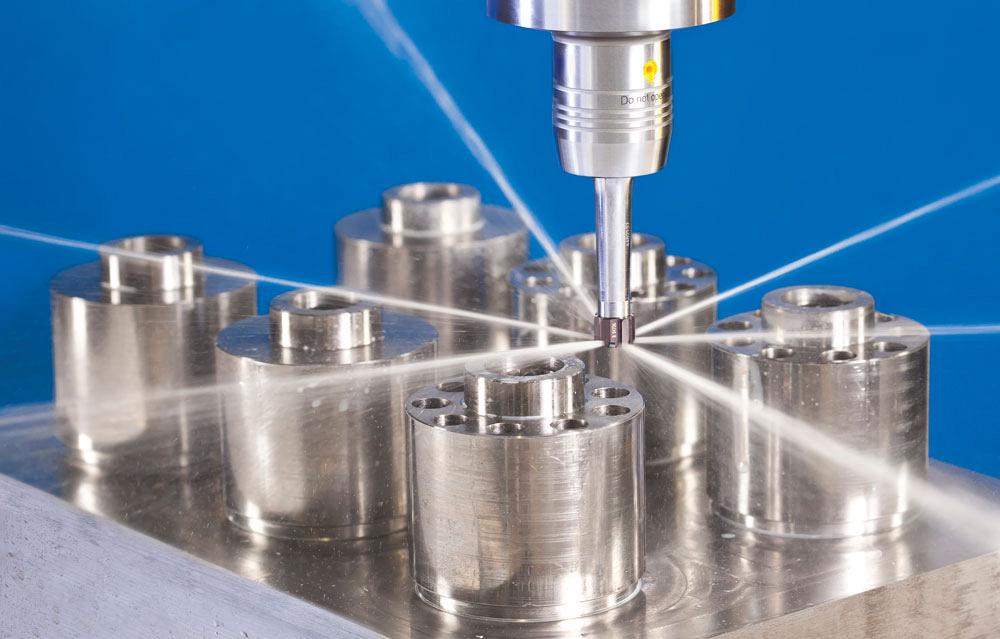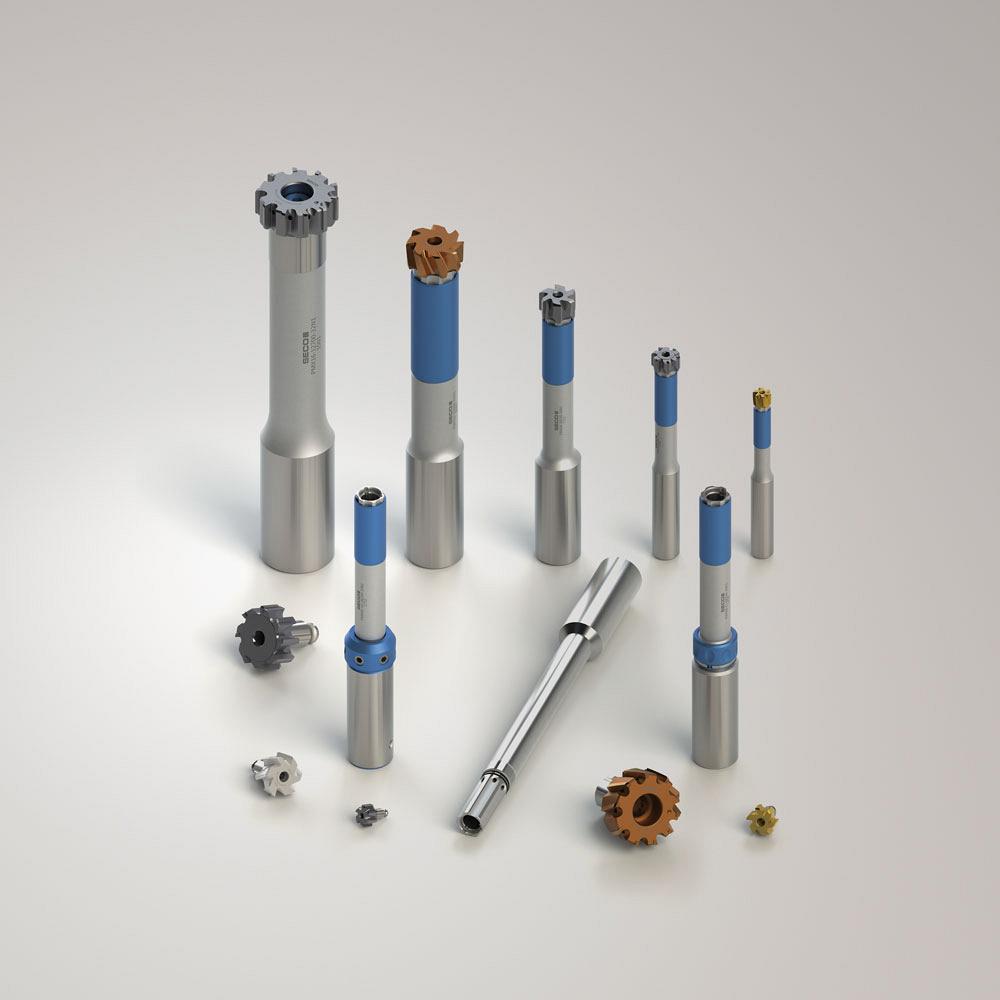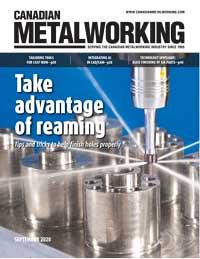Associate Editor
- FMA
- The Fabricator
- FABTECH
- Canadian Metalworking
Take advantage of reaming
Tips and tricks to help finish holes properly
- By Lindsay Luminoso
- September 17, 2020
- Article
- Cutting Tools

Reaming is highly temperamental. It needs to be treated as a finishing operation, not as a roughing operation. Photo courtesy of Iscar.
Holemaking is a common process on the shop floor, and every machine shop has its own way of handling this operation. However, when it comes to finishing holes, reaming offers lots of benefits.
Reaming is a particular process performed at the end of the cycle of producing a manufactured product. It’s the very last operation a shop tends to put into a part. At this stage of the game, these almost-finished components have had a lot of value put into them and usually are very expensive. Scrapping a part that is nearly complete can be very frustrating. This is why shops should investigate how reaming, if done properly, can help turn in-process holes into finished products.
"It’s important to remember that reaming is a finishing operation," said David Vetrecin, holemaking product manager, Iscar Tools, Oakville, Ont. "If there is a tight tolerance or a surface finish requirement in a hole, then reaming would be the quickest way of performing that operation."
Reaming is one of the two most frequently used processes to finish a hole. To do this, a shop needs to increase the diameter of the premachined hole—mostly drilled, but also bored or countersunk—by removing a relatively small amount of material. This is done to achieve the defined diameter tolerances, including roundness, straightness, surface finish quality, and position.
"These tolerances are typically not achievable with drilling or any other non-chip-lifting manufacturing method, like casting, forging, or additive manufacturing," said Michael Hacker, senior global product manager, indexable drilling, combination tools, and hole finishing, Kennametal, Fürth, Germany. "However, it is important to note that reaming is common on applications with big lot sizes, where productivity is critical."
Hacker added that when big lot sizes are machined, a specific reamer for the required hole diameter and tolerance pays off, as reamers typically have more than one cutting edge. Thus, machine downtime is less because the frequency of indexing the reamer or insert is lower.
The experts agreed that a reamer should be selected based on several factors, including diameter, tolerance, and grade fitting to the workpiece material.
As a finishing process, reaming cannot be just an afterthought. The material being machined often is very expensive, especially if it is a high-temperature alloy or something used for an aerospace component, so the process really requires careful consideration.
"It’s not like a standard insert or a milling cutter that you just use in any face mill or square shoulder cutter," said Manfred Lenz, product manager, holemaking, Seco Tools, Troy, Mich. "For the most part, in these milling operations, you can pretty much get away with using anything, but when it comes to reaming, it’s very particular based on a range of specifications."
Ream Properly
"Reaming is a very temperamental operation," said Vetrecin. "I would say everything needs to be exact for it to work properly, and that’s highly overlooked in the industry."

A reamer should be selected based on a several factors, including diameter, tolerance, and grade fitting to the workpiece material. Photo courtesy of Kennametal.
The experts agreed that a reamer should be selected based on several factors, including diameter, tolerance, and grade fitting to the workpiece material. A good place to start is in a product catalogue, which outlines many of the guidelines needed to ream effectively.
"The best thing for any shop to do is go through the process and determine all key specifications," said Lenz. "Product managers can make recommendations if they know all of the desired outcomes. There are many questions to ask, like is reaming a new process for the company or have they been doing it for years; and if they have reamed before, were there any issue or failures. One of the big things we want to know is why a customer is calling us so we can best solve the challenges at hand. Beyond that, decisions should be made based on hole tolerance and hole size."
According to Hacker, there are some general guidelines to help shops better ream:
- Stock needs to be 0.01 in. ±0.002 in. diameter. This value is independent of the nominal diameter of the hole. Smaller stock normally leads to better surface finish quality.
- If feasible, a chamfer machined with a single-point tool before reaming helps to improve positioning quality.
- Coolant has to include sufficient lubricant to guarantee the required surface finish quality. Dry reaming won’t provide satisfactory results. Minimum quantity lubrication (MQL) is ideal for reaming, as lubrication is much more important for reaming than cooling.
- The right cutting parameters have to be selected. This can be done by consulting the tool manufacturer’s catalogue.
Common Challenges
Although shops can encounter several challenges when it comes to reaming, Vetrecin noted that workholding and runout account for 90 per cent of the issues shops tend to encounter.
"If workholding and runout of the tool are correct, there’s a good chance that everything is going to work great," he said. "However, without these two things in place, there’s almost a 100 per cent chance reaming will not go well."
When shops are troubleshooting common reaming challenges, one of the first things they should do is check the spindle to see if there’s any runout or misalignment in the machine.
"Generally, I would check this before looking at the specific application," said Vetrecin. "We would check it a few times before running the application. If it’s not correct, we can fix it. And like I said, 90 per cent of the time, this is the problem."
With excessive runout and misalignment, shops often find that the hole has retraction marks. In these situations, the experts recommend slightly reducing the retraction speed of the reamer, especially if machine runout is unavoidable.
"Retract the reamer at a rate of five times faster coming out as going in, while giving it the appropriate feed rate so the tool is not pulling out, causing those swirl marks," said Lenz. "Adjusting feeds and speeds can often yield the desired result."
When it comes to workholding, a rigid setup can make all the difference in successfully reaming a hole. Without the proper fixturing, vibration can occur. The experts agree that adjusting the speeds and feed, by slowing down the speed but increasing feed, will help limit vibration.

Reaming requires the correct tool, and not investing in it can be more costly in the long run. Photo courtesy of Seco Tools.
If a shop is still experiencing challenges with reaming after these adjustments, Lenz suggested looking at the tool itself.
"Sometimes shops try to hold super-tight tolerances, but they don’t want to spend the money on the right reamer to get the job done correctly," said Lenz. "This operation definitely requires the correct tool, and not investing in it can be more costly in the long run. But I do see this as a common problem, and I’m not sure if it’s an issue because the shop is unfamiliar with reaming or they are just trying to get around spending the money for a small operation."
The type of reamer, geometry, grade, speeds and feeds, and price will all help determine the effectiveness of the process.
For surface finish issues, lead geometry can play a big role. There are many options available on the market that will help provide the right surface finish.
"An edge lead angle will provide excellent chip control, whereas a double angle will give a better surface finish," said Lenz. "The shallower the angle, the better the surface finish. If you have the proper lead geometry and still encounter surface finish issues, you can slowly reduce the feed rate. Shops will notice that they tend to get feed lines the faster they go. Reducing the feed rate can help with this issue."
Tips and Tricks
"One of the biggest misconceptions I’ve come across with reaming is that some shops ream when they really don’t need to," said Vetrecin. "There are some instances where a shop can get away with drilling the hole instead of reaming. It’s important to know when reaming is the best choice."
However, if reaming is required or is a fairly new process being introduced into a shop, there are some surprisingly similar tips that machinists pick up from other cutting tools that can be applied to reaming. Hacker noted several common considerations that shops should take into account:
- If the machined hole is too small, even if the reamer is new and the correct size, the workpiece may have been heated by roughing operations. When cooled down, the workpiece shrinks and with it all dimensions.
- If a fish skin pattern is observed, reducing stock can help, as can using a high lubricant content in the coolant.
- If the hole is elliptic, and the orientation is always the same, this might be the sign of a weak workpiece and the clamping force of the fixture is too high.
- If lobing is observed, in most cases this is because of even spacing of the teeth. The only way to avoid lobing is uneven spacing, the more the better.
"Reaming is highly temperamental," said Vetrecin. "It needs to be treated as a finishing operation, not as a roughing operation. There is really less care that goes into roughing. You’re just hogging material. When you’re reaming, there are a lot of variables that need to be addressed before it’s going to work properly. But one thing is certain, the better the roughing finish in the prehole, the better the finish and tool life will be with reaming."
Associate Editor Lindsay Luminoso can be reached at lluminoso@canadianmetalworking.com.
Iscar Tools, www.iscar.com
Kennametal, www.kennametal.com
Seco Tools, www.secotools.com
About the Author

Lindsay Luminoso
1154 Warden Avenue
Toronto, M1R 0A1 Canada
Lindsay Luminoso, associate editor, contributes to both Canadian Metalworking and Canadian Fabricating & Welding. She worked as an associate editor/web editor, at Canadian Metalworking from 2014-2016 and was most recently an associate editor at Design Engineering.
Luminoso has a bachelor of arts from Carleton University, a bachelor of education from Ottawa University, and a graduate certificate in book, magazine, and digital publishing from Centennial College.
Related Companies
subscribe now


Keep up to date with the latest news, events, and technology for all things metal from our pair of monthly magazines written specifically for Canadian manufacturers!
Start Your Free Subscription- Trending Articles
Automating additive manufacturing

Sustainability Analyzer Tool helps users measure and reduce carbon footprint

CTMA launches another round of Career-Ready program

Sandvik Coromant hosts workforce development event empowering young women in manufacturing

GF Machining Solutions names managing director and head of market region North and Central Americas

- Industry Events
MME Winnipeg
- April 30, 2024
- Winnipeg, ON Canada
CTMA Economic Uncertainty: Helping You Navigate Windsor Seminar
- April 30, 2024
- Windsor, ON Canada
CTMA Economic Uncertainty: Helping You Navigate Kitchener Seminar
- May 2, 2024
- Kitchener, ON Canada
Automate 2024
- May 6 - 9, 2024
- Chicago, IL
ANCA Open House
- May 7 - 8, 2024
- Wixom, MI















